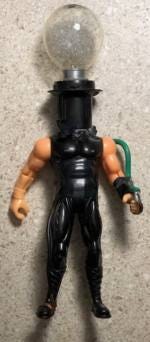Dear Readers,
Here’s info on Hot-Skin Voltage and feedback from my RVelectricity seminar at the 2020 Boston RV Expo.
While I covered everything from campground pedestal measurements to using digital meters to surge protector selection and operation, the demonstration that got the most comments during and after the seminar was showing how to detect a hot-skin condition using a Non-Contact Voltage Tester. And yes, it starred my tiny Volkswagen micro/micro bus and Flash (the action figure). So here’s a brief recap of what hot-skin voltage is, what causes it, and how to test for it with a simple $15 tester you can buy in any big box store or on Amazon.
Quite simply, any time the chassis (and skin) of your RV is electrically charged to more than a few volts above earth ground, it can create what’s called a hot-skin/contact-voltage condition. And when that occurs, if you’re standing on wet ground outside of the RV and touch anything metal (such as a door handle, hitch or even the tow vehicle), your body can complete the electrical circuit which allows current to flow through your body.
Now, contrary to what you’ve seen on television or the movies, touching 120 volts AC generally won’t produce a big blue glow, or sparks or any other pyrotechnics. It simply sends anywhere from 10 mA (10 milli-amperes or 0.010 amps) to 100 mA (0.100 amps) of current though your body. And only 10 mA to 30 mA of current through your heart can put it into fibrillation which can result in death within 5 minutes or so without emergency intervention. Note that this is about the same amount of current required to run even this tiny 2-watt night light bulb at 120 volts (16 mA or 0.016 amps). So there really are no big sparks or glowing lights surrounding your body if you touch a hot-skin RV, but your heart can certainly be put into danger.
The one demonstration I did at the Boston RV show that got a lot of attention was my desktop hot-skin demonstration where I charge up the chassis and skin of a small RV model with up to 120-volts AC, then show how you can test for it with a $15 Non-Contact Voltage Tester. I really got a lot of questions about that demonstration during my RVelectricity seminar, as well as out in the hallway where I answered questions for the next hour. Click on the screen shot (“People like Mike!”) to see what one of my attendees said about my seminar.
How to check with a Non-Contact Voltage Tester…
I was demonstrating how to test for an RV hot-skin/contact-voltage with something called a Non-Contact Voltage Tester, which is basically a pen-sized device that will detect a voltage potential of more than around 40 volts AC on an RV skin or chassis. And that’s even for NCVTs that are rated from 90 or 100 to 1,000 volts. Their low-voltage range is only applicable when they’re testing a small object like an extension cord. But put an RV in front of them with hundreds of square feet of surface area, and these NCVT pens will beep and buzz with an RV hot skin as little as 40 volts, and from 1 to 2 feet away if the RV has a hot-skin of 120 volts.
But wait, there’s more…
If you want to read more about what causes hot-skin voltage on an RV, then I’ve got you covered there as well. At the end of this paragraph is a link to one of my advanced articles on the various causes of low-, medium- and high-current hot-skin/stray-voltage conditions, as well as a few troubleshooting methods. But remember, just because you have a low-current hot-skin condition today that may only tingle you a bit, it can turn into a medium- or high-current hot-skin condition in a heartbeat (literally!). So please take all hot-skin/contact-voltage conditions seriously. Read more about it HERE.
And let’s not forget Flash, the action figure
Yes, he only has a flash bulb for a brain so there’s not a lot of smarts there. But Flash has faithfully showed us all dozens of times what happens if you’re standing on the wet ground and touch any energized metal surface on your RV. In his case he blows his top (actually ignites a flash bulb), but in your case that could be your heart going into fibrillation.
So please get yourself a Non-Contact Voltage Tester, and always check your RV for a hot-skin/contact-voltage condition any time you plug into shore power. And never accept feeling a shock from an RV (or any electrical appliance) as normal. When that happens it’s a hint that the next shock could electrocute you or a loved one, and that’s a totally preventable tragedy if you simply pay attention and don’t accept shocks.
Let’s play safe out there… Mike











Mike…you brought this to my attention about 8-9 years ago when I first got on your frequency. Since then I’ve been using my Fluke NCVT every time we hook up to a pedestal. So far, I’ve never encountered a hot skin, but I ALWAYS check!
Mike, You wrote: "...only 10 mA to 30 mA of current through your heart can put it into fibrillation which can result in death within 5 minutes or so without emergency intervention."
What is the best way to rescue a person who has receives an electrical shock and gone into A-fib? An article on first aid to electrocution victims would be well received.